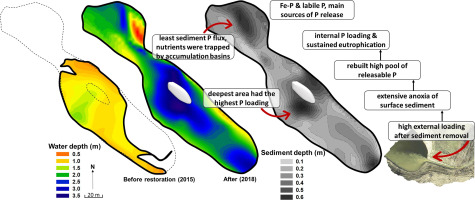当前位置:
X-MOL 学术
›
Sci. Total Environ.
›
论文详情
Our official English website, www.x-mol.net, welcomes your feedback! (Note: you will need to create a separate account there.)
Internal phosphorus loading in a small shallow Lake: Response after sediment removal.
Science of the Total Environment ( IF 9.8 ) Pub Date : 2020-03-27 , DOI: 10.1016/j.scitotenv.2020.138279 Mina Kiani 1 , Priit Tammeorg 1 , Juha Niemistö 2 , Asko Simojoki 1 , Olga Tammeorg 3
Science of the Total Environment ( IF 9.8 ) Pub Date : 2020-03-27 , DOI: 10.1016/j.scitotenv.2020.138279 Mina Kiani 1 , Priit Tammeorg 1 , Juha Niemistö 2 , Asko Simojoki 1 , Olga Tammeorg 3
Affiliation

|
Mankind is taking advantage of numerous services by small shallow lakes such as drinking water supply, irrigation, and recreational function; however, many of these lakes suffer from eutrophication. Given the key role of phosphorus (P) in eutrophication process, one of the effective restoration methods especially for small shallow lakes is removal of sediments enriched with nutrients. In our study, we used interannual, seasonal, and spatial data to examine the changes in sediment P mobility after removal of sediments in 2016 from a 1-ha highly eutrophic lake. We measured the sediment redox potential, analyzed soluble reactive P (SRP) in the pore water and P fractional composition of the surface sediments, and calculated the diffusive flux of P in three locations in two continuous years (2017 and 2018) after the excavation. Similar measurements were done before sediment removal at central site of the lake in 2015. Removing nutrient-rich sediment also removed 6400 kg of P, and thus the potential for release of P from sediments decreased on a long-term scale. However, a large pool of releasable P was rebuilt soon after the sediment removal due to high external P loading, resulting in extensive anoxia of sediment surface and associated internal P loading as high as 1450 mg m-2 summer-1. Moreover, the Fe-P and labile P fractions were the most important sources of P release, as evidenced by their considerable seasonal and interannual changes after the sediment removal. The sediment total Fe negatively correlated with diffusive flux of P, pore water SRP, and near-bottom water total P and SRP concentrations which indicated a strong linkage between sediment P dynamics and Fe after the restoration. Sediment removal could be a beneficial restoration approach, but the effects on lake water quality remain only short-term unless there is an adequate control on external loading to the lake.
中文翻译:

小型浅湖中的内部磷负荷:去除沉积物后的响应。
人类正在利用浅水小湖提供的大量服务,例如饮用水供应,灌溉和娱乐功能。但是,这些湖泊中许多都富营养化。鉴于磷在富营养化过程中的关键作用,一种有效的恢复方法(特别是对于小型浅湖而言)是去除富含营养物的沉积物。在我们的研究中,我们使用年际,季节和空间数据检查了2016年从1公顷高度富营养化湖泊中去除沉积物后沉积物P迁移率的变化。我们测量了沉积物的氧化还原电位,分析了孔隙水中的可溶性反应性P(SRP)和表面沉积物的P分数组成,并计算了开挖后连续两年(2017年和2018年)三个位置中P的扩散通量。在2015年在湖中心位置去除沉积物之前进行了类似的测量。去除富含营养的沉积物还去除了6400 kg的P,因此从沉积物中释放P的潜力在长期范围内降低。然而,由于高的外部磷负荷,在沉积物去除后不久便重建了一大堆可释放的磷,导致沉积物表面广泛的缺氧和相关的内部磷负荷高达1450 mg m-2 summer-1。此外,Fe-P和不稳定的P馏分是P释放的最重要来源,沉积物去除后它们的季节性和年际变化都很大。沉积物总Fe与P扩散通量,孔隙水SRP,恢复期后,沉积物磷动力学与铁之间的强烈联系表明水的总磷和SRP浓度接近于底部。去除沉积物可能是一种有益的恢复方法,但是除非对湖泊的外部负荷进行适当控制,否则对湖泊水质的影响仍将是短期的。
更新日期:2020-03-27
中文翻译:

小型浅湖中的内部磷负荷:去除沉积物后的响应。
人类正在利用浅水小湖提供的大量服务,例如饮用水供应,灌溉和娱乐功能。但是,这些湖泊中许多都富营养化。鉴于磷在富营养化过程中的关键作用,一种有效的恢复方法(特别是对于小型浅湖而言)是去除富含营养物的沉积物。在我们的研究中,我们使用年际,季节和空间数据检查了2016年从1公顷高度富营养化湖泊中去除沉积物后沉积物P迁移率的变化。我们测量了沉积物的氧化还原电位,分析了孔隙水中的可溶性反应性P(SRP)和表面沉积物的P分数组成,并计算了开挖后连续两年(2017年和2018年)三个位置中P的扩散通量。在2015年在湖中心位置去除沉积物之前进行了类似的测量。去除富含营养的沉积物还去除了6400 kg的P,因此从沉积物中释放P的潜力在长期范围内降低。然而,由于高的外部磷负荷,在沉积物去除后不久便重建了一大堆可释放的磷,导致沉积物表面广泛的缺氧和相关的内部磷负荷高达1450 mg m-2 summer-1。此外,Fe-P和不稳定的P馏分是P释放的最重要来源,沉积物去除后它们的季节性和年际变化都很大。沉积物总Fe与P扩散通量,孔隙水SRP,恢复期后,沉积物磷动力学与铁之间的强烈联系表明水的总磷和SRP浓度接近于底部。去除沉积物可能是一种有益的恢复方法,但是除非对湖泊的外部负荷进行适当控制,否则对湖泊水质的影响仍将是短期的。



























 京公网安备 11010802027423号
京公网安备 11010802027423号